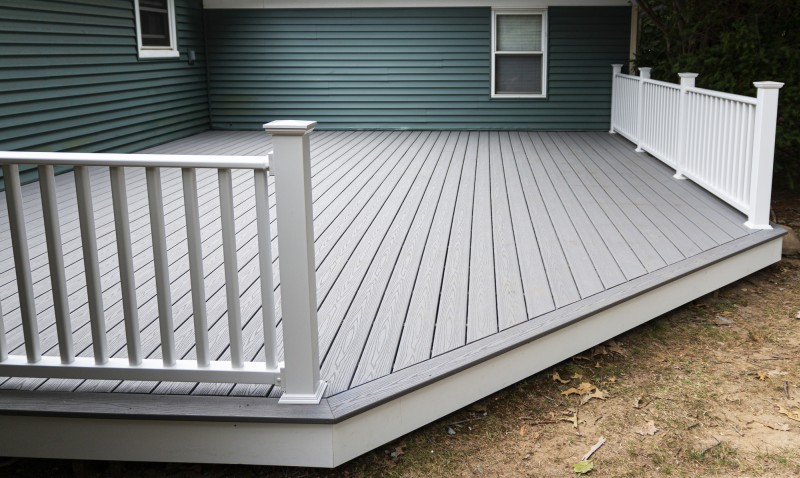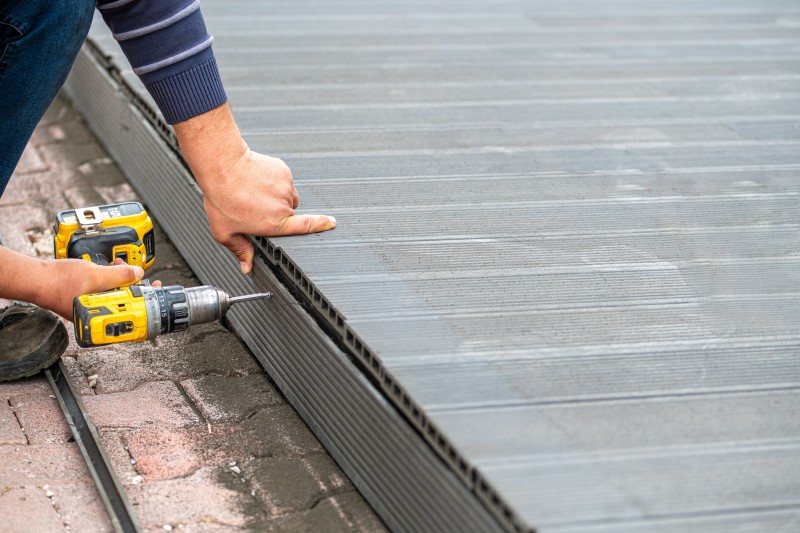In this article we’ll describe and discuss the pros and cons of PVC Decking for your home, so keep reading to find all the details below.

If you’ve an interest in the origins of PVC decking materials, even your favorite search engine could confuse you when you try to learn more about this popular option.
One website insists the inventors of this material were brothers Dino and Marco Terragni, who patented this type of decking in Milan Italy in 1960, while another credits inventor Roger Wittenburg who combined shredded plastic and sawdust to produce this material in 1988.
In fact, these are composite products rather than PVC, which is where the confusion originates.
Not only will you run into composite deck materials that invite mold and mildew due to the organic nature of these boards when you search for PVC, but you’ll also be confused by references to PVC vinyl products.
No wonder it’s good to have an expert on hand to separate the real thing from other types of decking materials.
What is true PVC Decking?
Perhaps the best way to answer this question is to explain what it’s not! PVC deck boards are crafted of 100% high-strength plastic, and even though PVC deck board is often incorrectly confused with vinyl, the distinction is clear.
Polyvinyl chloride (PVC), with or without the addition of foaming agents that can reinforce the board’s strength, is a unique product produced as board rather than a rolled-out medium that distinguishes vinyl decking products.
The advantages of choosing PVC decking material are numerous. These boards are not only scratch- and stain-resistant but low maintenance and the colors, textures and types of PVC decking continue to contribute to the diversity and appeal of this popular material. Keep reading to learn more about this revolutionary material.
Advantages of PVC Decking
It’s certainly to your advantage to opt for PVC over vinyl for the following 8 reasons:
1) Busy homeowners appreciate the fact that PVC requires minimal upkeep, so you won’t have to repaint or stain down the road. Further, you can power wash this material without worrying about splintering.
2) PVC deck products offer consumers 25 years+ of enjoyment because this type of plastic is so durable.
3) Given seasonal exposure to all types of weather, the risk of mold and insect infestation remains high when using composite or all-wood products, but PVC resists both as well as offering color fading protections.
4) Color and design options are so vast; PVC can replicate the color and look of pricier wood decking materials.
5) PVC is not just 100% recyclable, but it can be refinished and recycled since PVC is usually manufactured from virgin materials so using it can help reduce the planet’s carbon footprint.
6) Projects crafted of PVC decking are likely to take less time to complete because this material is lighter, which means transporting the product to the site is faster and installing it requires less effort.
7) For active families, the ability to enjoy a deck that is made of scratch resistant materials is a priceless benefit. Since you won’t have to worry about wear and tear or stains, no worries about spilled beverages or damage from moving furniture or barbeque grills.
8) Many PVC decking manufacturers are generous when it comes to offering long warranty terms, so when shopping for the product that meets all the criteria on this list, be sure to ask about this, too.

Disadvantages of PVC Decking
Referred to as “the relative new kid on the block” by contributing editor Mark Petersen writing for the Family Handyman website, there’s no denying the rising popularity of PVC decking products among contractors and homeowners, but this material comes with negatives, including these 7 disadvantages.
1) PVC is not kind to folks budgets if they are seeking the least expensive decking option. Contractors say that PVC decking material is frequently priced at a premium over composites of the same quality, which can cause some confusion since there are several grades of this material.
2) PVC may not appeal to homeowners who want their decks to look authentic because this plastic material is obviously crafted of synthetic materials. If aesthetics are a priority for you, all the benefits in the world may not compensate for the look you crave. Further, “hidden” fastening options may not be attractive features.
3) PVC may extol the virtues of a material that won’t fade or lose color, but in fact, if this decking material encounters rubber or select PVC products (e.g., a welcome mat), you could wind up with unpleasant contact stains, reasons manufacturers warn of when they promote their PVC decking products.
4) Content claims can be suspect, say critics who refute claims of a reduction of carbon footprint as a selling point when promoting PVC. As a rule, PVC is made of virgin materials so be leery of claims that this decking type has a potential to be recycled.
5) Sunlight’s UV rays can damage PVC over time, despite claims to the contrary, and while PVC products cloak themselves in the little-to-no maintenance mantle, homeowners must still be prepared to unclog gaps between the planks and clean up spills to avoid staining.
6) PVC decking products can become too hot to walk on without shoes if you live in a hot climate, and because it expands and contracts with all temperature changes and during the installation process, contractors report that PVC “bounces” more than other decking mediums.
7) While extremely durable, PVC can’t handle the same weight as a wooden or composite deck, which is a trade-off for this lightweight material. But if you aren’t hosting huge gatherings of hefty people on a regular basis, you shouldn’t have to worry about this!
Differences between composite and PVC decking
Not every homeowner can discern major differences between these two mediums, but the following are the most often cited differences when making comparisons:
- PVC’s all-plastic construction does a decent job of imitating wood, but capped composites look more authentic.
- Both PVC and composite score equally high when it comes to overall durability and strength.
- Capped PVC decking’s ability to repel mold and mildew will always be superior to composites.
- PVC is more likely than composites to exhibit splinter-free surfacing since no wood fibers are used to manufacture it.
- Composite deck prices tend to be lower than those of comparable constructs made of PVC.
- Color choices are myriad when compared to composites where limited color palettes tend to be the order of the day.
How long can you expect your PVC deck to last?
Because the amount of time and attention a homeowner devotes to caring for a deck differs, there seems to be a disparity in the longevity of PVC decking materials as cited by various manufacturers.
Some insist that the average PVC deck will only stick around for 20 years while others claim that a homeowner can expect to enjoy 30 years of wear from the highest grades of PVC planks.
What is the average price of PVC decking
According to one resource, the average price ranges between $10 and $15 per square foot, but if you’re looking for a more explicit breakout, you must also factor in the quality of the PVC material, the size of the deck, the complexity of the overall design, cost-of-living in your area, and even the brand you choose will impact the final price tag associated with your unique project.
That stated, these ballpark figures should give you an idea of what you can expect to spend on your decking project:
- Using 5½” PVC planks, you’ll spend between $3.95- and $5.95-per plank.
- Deck material is likely to cost you between $8.65 and $17.95 per square foot.
- Labor costs can run between $5.95- and $11.95-per square foot.
Resources
https://www.composite-prime.com/composite-decking-guide/the-history-of-composite-decking/
https://solutions.dunnlumber.com/projects/the-history-of-manufactured-decking
https://decksandfencesbyryan.com/history-of-composite-pvc-decking/
https://www.decks.com/how-to/articles/differences-between-pvc-composite-decking
https://www.decks-docks.com/differences-between-composite-and-pvc-decking
https://blog.renovationfind.com/5-benefits-of-pvc-decking/
https://www.familyhandyman.com/article/maintenance-free-decking-pvc-vs-composite/ https://www.decks.com/how-to/articles/differences-between-pvc-composite-decking
https://www.timbertech.com/ideas/pvc-vs-composite-decking/
https://sherwoodlumber.com/pvc-vs-composite-decking/
https://plasticinehouse.com/pvc-vs-composite-decking/
https://www.flooringclarity.com/composite-vs-wood-vs-pvc-decking/
https://deckcostguide.com/deck-installation/pvc-plastic/
Related Posts
- 12 Different Types of Wood for Outdoor Furniture with Pros/Cons
- 11 Different Types of Natural Stone for House Exterior
- Advantages and Disadvantages of Composite Decking for Homes
- What Color Siding Goes With Red Brick? Design Ideas With Pictures
- 8 Unique Porch Ceiling Ideas for your Home (with Photos)
- Main Pros and Cons of Crashed Concrete for Driveways
Leave a Reply